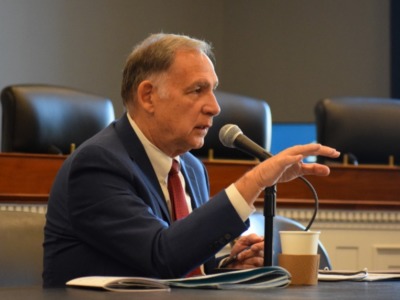There is growing agreement on Capitol Hill that Congress is almost certain to move an extension of the 2018 farm bill in the next month or two, and it could shake up cost estimates for modifications to commodity programs and other provisions.
The big question is not whether lawmakers will pass an extension but what the duration is. Sen. John Boozman, ranking Republican on the Senate Agriculture Committee, says a one-year extension is likely needed to give farmers and their bankers some certainty that commodity programs will be in place for 2024 crops.
House Agriculture Committee Chairman Glenn "GT" Thompson doesn't think the extension needs to be a year long. "I certainly have more confidence in John Bozeman than maybe he does," Thompson quipped.
Boozman said he didn't think it would take an entire year to get a new farm bill enacted. But a one-year extension would give lawmakers some cushion; they would have until after the 2024 election to get a bill to President Joe Biden’s desk.
On the other hand, a year-long extension, as opposed to a shorter one of some weeks or months, would also take some pressure off Congress to finish the legislation earlier next year.
“A shorter extension could push Congress to reauthorize before the 2024 campaign season takes over, but the current state-of-play in the House leaves little optimism for real progress” on a new farm bill, said Jonathan Coppess, a specialist in agricultural policy and law at the University of Illinois who ran USDA’s Farm Service Agency early in the Obama administration.
“A year-long extension would allow the potential for a lame duck 2024 reauthorization and avoid the need for multiple short term extensions. But that gambles on the results in 2024 and that Congress will want to do anything in a lame duck. If 2020 is any indication, the lame duck session could be consumed by the reactions to the election,” said Coppess, who also has been Chief Counsel to the Democratic staff of the Senate Ag Committee.
 Sen. John Boozman, R-Ark.
Sen. John Boozman, R-Ark.What is certain is that Congress has until Jan. 1 or - shortly thereafter - to pass an extension of some kind.
Otherwise, laws dating back to 1938 and 1949 will be triggered, forcing USDA to take steps next year to dramatically raise the price of milk, wheat and other commodities. The 1938 and 1949 provisions are collectively known as “permanent law” and have been left on the books to ensure Congress either passes a new farm bill or extends the expiring legislation.
Congress has taken the route of short-term extensions before, including in 2008, when a series of short extensions kept the pressure on negotiators to wrap up their work. Eventually, the farm bill was passed in the summer of what was a presidential election year.
Aside from throwing the farm bill into the fray of election-year politics, an extension would also have implications for the cost of modifying existing farm programs.
For example, cost estimates for changing the two main income support programs for row crops – Agriculture Risk Coverage and Price Loss Coverage – could be higher or lower than they are this year, depending on market price forecasts and a host of other variables. Changes to nutrition programs also could be affected.
That’s because the Congressional Budget Office is expected to update its 10-year estimates of farm program costs – the farm bill baseline - sometime early in 2024. CBO has been calculating estimates of farm bill modifications based on its 2023 baseline, issued in May. Depending on when the House and Senate Ag committees start work on their bills, CBO may switch to using the 2024 baseline, policy experts say.
If CBO were to lower its estimates of future market prices for commodities, raising PLC reference prices - a major priority for many farm groups - could be more expensive for Congress, said Pat Westhoff, director of the Food and Agricultural Policy Research Institute at the University of Missouri.
It’s easy to be “in the know” about what’s happening in Washington, D.C. Sign up for a FREE month of Agri-Pulse news! Simply click here.
On the other hand, he said, lower commodity price projections could make it less expensive to adjust an escalator provision for reference prices, he said. In a given year, reference prices are allowed to rise as much as 15% above the statutory reference price based on a five-year rolling average of market prices. The lower market prices are projected to be in future years, the less likely it is that the escalator provision will be triggered, everything else being equal, Westhoff said.
But Westhoff cautioned there are a number of factors beyond just market price projections that go into producing 10-year cost estimates for farm programs and potential modifications.
“People who have been talking as if they know for sure which way things will go might be making assumptions they shouldn’t be making. There's just too many moving parts,” he said.
A farm bill extension also could lower the amount of Inflation Reduction Act conservation funding that can be brought into the farm bill for the simple reason that USDA could have committed much or all of the fiscal 2024 funding by the time a new farm bill is enacted. The IRA provided USDA $18 billion for four conservation programs, $4.1 billion of which was authorized for spending in FY23 and FY24.
 Pat Westhoff, FAPRI
Pat Westhoff, FAPRIAnother potential concern for the Ag committees is that the estimated cost of the bill’s nutrition title also is likely to be lower in CBO’s 2024 baseline update, because the cost of the Supplemental Nutrition Assistance Program is coming in lower than CBO projected in May, said Westhoff.
CBO estimated SNAP would cost $145 billion in fiscal 2023, but the actual expenditures were under $135 billion; Westhoff said SNAP outlays are likely to be lower for FY24, as well, given the recent trend.
The lower cost estimates for SNAP likely mean modifications of the program could yield less savings.
Republicans would like to add provisions to the next farm bill that would restrict the ability of USDA to significantly alter benefit levels through an update of the economic model, called the Thrifty Food Plan, that’s used to estimate dietary costs. The restrictions would provide some savings that could be steered into other parts of the farm bill – if Republicans could convince Democrats to go along with the idea.
SNAP benefits have declined significantly with the expiration of pandemic-related increases. Benefits dropped to under $7.2 billion in July, down from $11.1 billion in December 2022 and the smallest amount of monthly benefits since March 2020, according to the latest USDA data.
For more news, go to Agri-Pulse.com.


